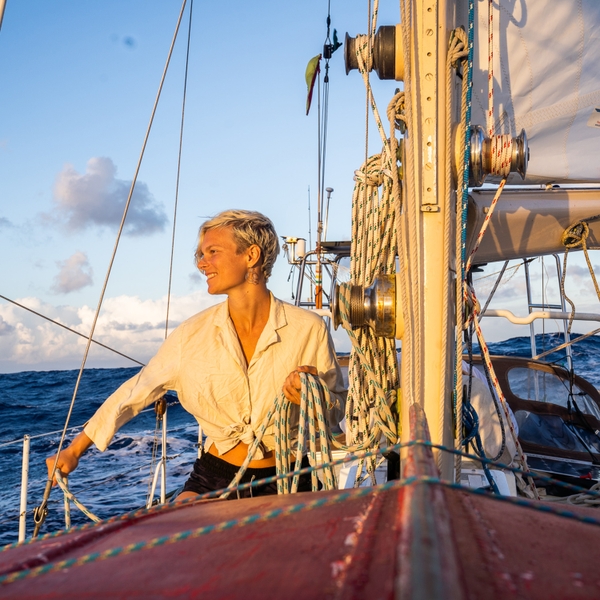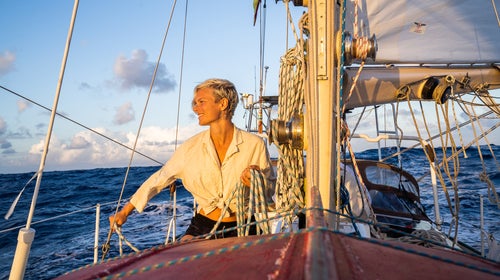Why Did One of the World’s Best Skiers Quit? Well, the Boat Had Something to Do with It.
Last year, Angel Collinson surprised everyone when she retired after a decade as a professional athlete. She’s still finding her way.
New perk: Easily find new routes and hidden gems, upcoming running events, and more near you. Your weekly Local Running Newsletter has everything you need to lace up! .
It’s the morning of April 5, 2019, in the middle of spine-hunting season for skiers on Alaska’s monster peaks. The skies are blue and the wind is light. The choppers will fly today. It’s also a new moon, which is relevant depending on who you ask. During this lunar phase, the moon is aligned between the sun and earth, making it invisible. This exerts a stronger gravitational pull, resulting in extremes in ocean tides: high highs and low lows. Those who are spiritually inclined note that it’s a good time for manifestation and setting intentions. While sitting in a treehouse in Palmer, a small town on the outskirts of Anchorage, 28-year-old professional skier Angel Collinson makes a list of all the things she wants in her life: to buy property, to love herself deeply, to dance more often. Then she writes that she wants to sail around the world. She has absolutely no idea where that last one came from.
A few hours later, Collinson stands on top of a thousand-foot line in the Chugach Mountains with fellow pros Nick McNutt and Griffin Post. Her small frame is clad in bright, baggy Gore-Tex. A film crew is waiting.
This is what she’s known for. Collinson built her career snaking beautiful turns down improbable faces. She’s one of the best big-mountain skiers in the world and has racked up nearly every accolade possible: she won the Freeskiing World Tour (twice), scored magazine covers, was the first woman to win Powder magazine’s coveted Line of the Year award, and is notable as the first woman to nab the opening and closing segments in a ski movie, something that typically goes to men. In 2016, this magazine published a piece titled “Angel Collinson Just Broke the Ski Industry’s Bro Ceiling.”
The terrain below the trio is over 50 degrees, has complicated sluff management, and starts with a blind rollover—all typical characteristics of the Alaskan lines they’re used to. The skiing is well within Collinson’s ability, but she has to nail it. She consults a photo of the line on her phone so she can visualize. A familiar rush of cortisol and adrenaline floods her system. She long ago made friends with the fear that joins her in these moments.
Now there’s nothing left to do but ski. McNutt goes first and quickly vanishes over the edge.
“How you feeling?” asks Post, while they wait for their turn.
“Feeling good… ish,” she says.
“You got this,” says Post, all he can muster as he tries to wrangle his own nerves.
“Yeah…,” she says, as if she’s unsure of her own answer. “I’m so tired of being scared all the time.”
Post drops in. Then it’s Angel’s turn. As she inches out over the edge, the snow below her black Völkls falls away into nothing. She takes a deep breath and drops in, laying down a few smooth turns. She needs to hit the ridge at just the right spot, but comes in a few feet too low. She stops, apologizes to the camera crew over the radio, and resets. She executes a sketchy kick turn and starts again. Almost immediately, her downhill ski punches through an unexpected layer of crust and lodges itself in the snow. The impact whips her backwards, spinning her downhill. Somehow she regains her edges, only to find herself atop a patch of exposed rocks. She hops and side-steps over them in a desperate attempt to recover, but falls again. Maybe I can stop, she thinks.
She can’t. Collinson tomahawks violently down the steep face, picking up speed. Her body cartwheels. Her skis are still attached. She feels a big, obvious pop: ACL, MCL, and meniscus. Post and McNutt watch in horror from below as her body rag-dolls down the face. Her vision blurs into a torrent of white as she tumbles nearly a thousand feet before sliding to a halt near the bottom of the slope.
“I’m all right,” she says calmly over the radio. Then she flips her camera around and films herself. Her face is flushed and her blond locks are a mess of snow and ice. “How do you like my hair?” she jokes, before exhaling. “That was gnarly.”
That morning when Collinson wrote down a list of things that would populate her dream life, skiing wasn’t on it.







